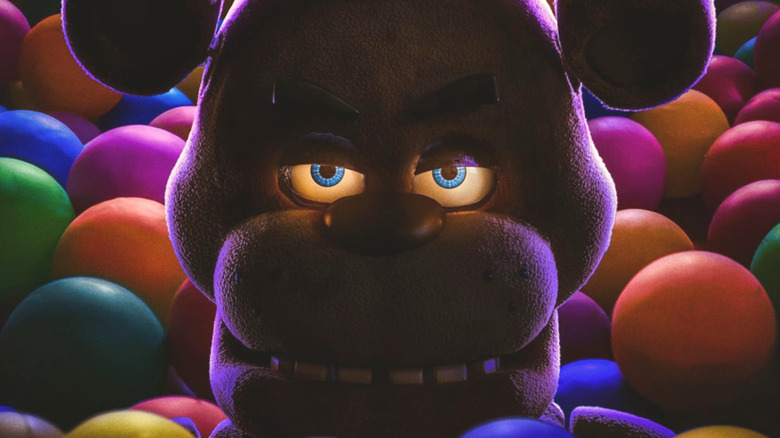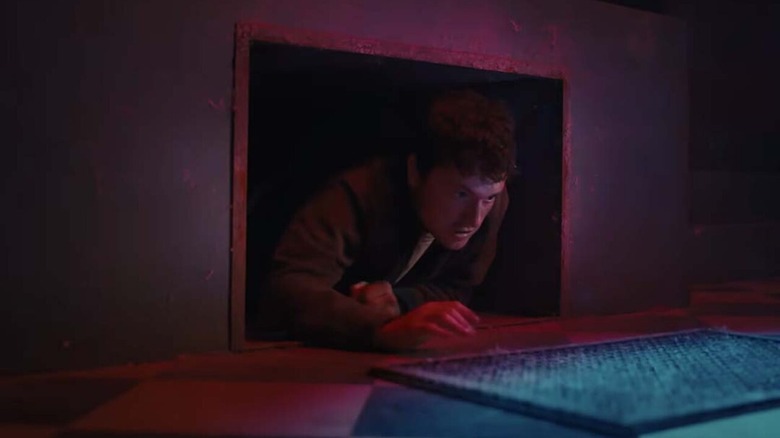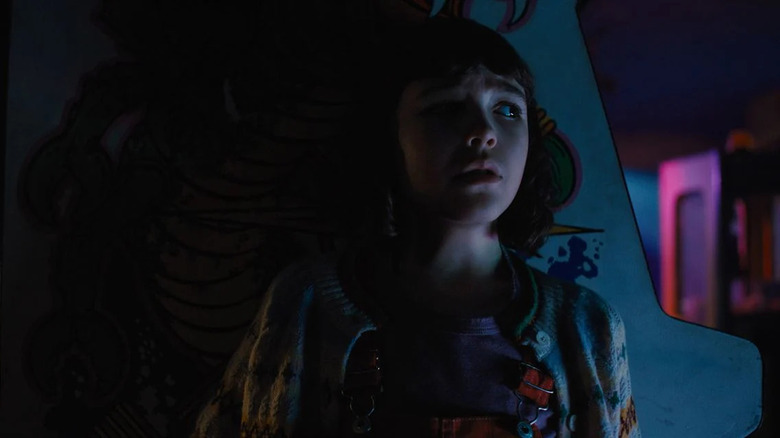Five Nights At Freddy's Is The Exact Opposite Of The Games In One Key Way
This article contains spoilers for "Five Nights at Freddy's."
Whenever someone says "I hate horror movies," there's a high probability that what they're really saying is "I hate jump scares." Of course, any good genre historian knows that there's far more to a horror film than a jump scare, but by and large, folks who don't enjoy horror films typically don't enjoy the sensation of feeling scared above all else. That rush of adrenaline can be a thrilling impression for many, but deeply uncomfortable for others. Enduring that feeling is often part of the allure — a means to test the limits of body and mind without having to put yourself in any real danger.
It's this very feeling that helped catapult the indie video game "Five Nights at Freddy's" into a cultural phenomenon. The first "FNaF" game is simple in its execution — players watch security camera screens and conserve power to prevent the animatronics of Freddy Fazbear's Pizza from entering the security office and killing them. It's an exercise in tension, as players know they might pull down the security screen to suddenly see an animatronic standing in the doorway, or earn a dreaded "Game Over" accompanied by an animatronic's face covering the full screen and screaming.
At no point is the player ever in harm's way, but the threat of the jump scare is enough to get the heart racing. The popularity of "Five Nights at Freddy's" is somewhat synonymous with jump scares, so filmgoers who hate jump scares might feel like this is a film to miss. Fortunately, director Emma Tammi had more in her filmmaking arsenal than to completely rely on a jolt to the nervous system.
Dread, heartbreak, and grief
Of course, "FNaF" does feature some jump scares, but the point is that the film has so much more going on than only jump scares. Security guard Mike Schmidt is continually haunted by the memory of his little brother Garrett being kidnapped and sees visions of dead children once he starts falling asleep on the job at Freddy Fazbear's. His pain is very real, and there are some solid scares rooted in the dread of feeling responsible for your brother's death.
Additionally, the entire setting of Freddy Fazbear's Pizza is unsettling without the threat of a jump scare, as the juxtaposition of filth and rot against the backdrop of childhood wonder is certainly enough to have audiences squirming in their seats. With such a heavy backstory for Mike Schmidt, it makes all of the events of "FNaF" feel more intense. There's also the risk that he's going to lose Abby forever either through custody separation or that she'll be killed by the animatronics. In both scenarios, Mike is processing serious, permanent fears and if the audience is empathetic enough, they'll feel his pain as well.
The fear that comes from the animatronics isn't exclusive to the concern that they'll jump scare in front of the screen, either. They're methodical and slow-moving, and much of the terror comes from the inevitability. They're hulking, they're powerful, they're dangerous, and their wrath will be painful. Watching someone face off with the animatronics is a lot like watching someone wait for the clock to start in a "Saw" trap. The audience knows it's coming, and that wait can feel excruciating. It's a completely different sensation than a jump scare, and that's a good thing.
Fear for the whole family
As twisted as the lore of the "Five Nights at Freddy's" games is, the series has never been one for graphic kills or gore. Even the more terrifying moments, like the death of the Crying Child in the Bite of '87, are portrayed through 8-bit cutscenes. This means that the live-action adaptation could have done whatever they wanted to showcase some of the series' most memorable moments, but the creative team wisely chose to maintain the series' universal appeal. Even the youngest "FNaF" fans, including the kids who have been playing the games on their iPads before they started blowing out double-digit candles on their birthday cakes, can enjoy this movie. Gateway horror movies are a vital subgenre, and "Five Nights at Freddy's" is a phenomenal inclusion to the canon.
By taking multiple approaches to crafting scares, "FNaF" becomes a great introductory tool to other horror subgenres. The ghost story of the dead children, the slasher threat of William Afton, the monstrous larger-than-life presence of the animatronics, the unknown creeping in the dark, and the human danger of Aunt Jane all lend themselves to future, more adult horror films. It sounds blasphemous, but the reality is that the new generation isn't getting introduced to horror through Michael Myers, Freddy Krueger, or even films like "Alien" anymore. They're discovering creepypasta stories as iPad babies and playing games like "Five Nights at Freddy's." The movie serving as a gateway to the genre as a whole and not just a frenzy of jumpscares is the best approach possible.
"Five Nights at Freddy's" is currently playing in theaters and available to stream on Peacock.


